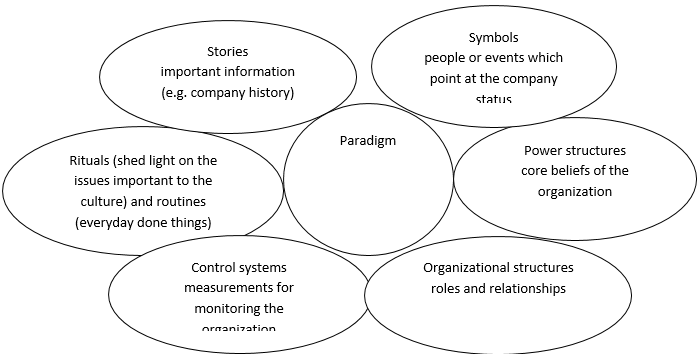Introduction
The cultural web is a means of analyzing culture. According to Johnson, Scholes, and Whittington, the cultural web “shows the behavioral, physical and symbolic manifestations of a culture that inform and are informed by the taken-for-granted assumptions, or paradigm” (p. 197). There are seven elements of the cultural web, which may be presented in the following scheme:

The six elements of the cultural web are aimed at reinforcing the assumptions within the paradigm. A paradigm can be called a collective experience that can be related to the situation with the purpose to understand its main idea. The cultural web is used for comprehension of the culture of the organization and its interrelations to the strategy of a particular organization.
Stakeholders Analysis
Stakeholders are all the people who can be significantly affected by another person’s actions or decision-making activity. Stakeholders are classified under the three parameters of Power, Legitimacy, and Urgency. Power is the ability to influence other stakeholders’ actions. Legitimacy is the normative appropriateness of a stakeholder to change other stakeholders’ actions. Urgency is the time-sensitiveness and cost level in case a stakeholder’s claims or interests are delayed.
A dormant stakeholder has the power to influence action but has neither legitimacy nor urgency. A discretionary stakeholder has legitimacy but lacks urgency and the power to change the actions of other stakeholders. A demanding stakeholder has the urgency in claims but neither legitimacy nor power. Stakeholders need to be analyzed because their ideas and contributions need to be considered in the organization’s operations (Capon, 2008).
The Value Chain
The value of service must be added at every level to have a competitive advantage over other firms in the same industry. Each service should be conducted individually but make it a part of an overall system. The results of this service are greatly improved when it is brought down to focus groups and viewed as a component of the overall set of services offered. This is done through increasing value by cutting prices i.e. the benefits that a customer gains from a service should be more than the perceived price of the service. The perceived benefits of service should be increased more compared to the increase in price, especially where there are price wars in the industry. A firm seeks to achieve this advantage to gain employee commitment and increase customer loyalty.
Porter’s Five Forces Model and the Fast Food Industry
The five forces act to either bring down the profitability of a market or make it an attractive one. The forces are both internal and external. The UK fast food industry is attractive and many firms enter it, reducing customer base and profit level for existing ones (the threat of new entrants). Most customers are shifting to other substitutes due to fast food ‘unhealthy’ nature (substitute products).
The UK market is very price-sensitive; any price changes would shift the sales volume of firms in this industry (customer’s bargaining power). Labor unions make it hard for firms to change employees while the cost of switching suppliers is also high (bargaining power of suppliers). Most firms in this market are doing business online. This takes away both existing and potential customers (Existing competition).
Worldwide Strategies
Financial ability of the firm, skills, and technical ‘know-how’ and ease of entry influence a firm’s choice of worldwide strategy. Some possible strategies include licensing, franchising, exporting, turnkey projects, and agents’ use. Exporting involves a company which either directly or indirectly sells products produced cheaper in its home country than in other countries. Strategic alliances are collaborations between two companies to gain leverage in a market together while remaining as independent entities. Companies could use this to gain an advantage in distribution, production, manufacturing capability, or project funding. The acquisition is the strategy where one company takes over another through mergers or the buying of a particular product or product line.
Turning a Failing Company into a Successful Business
This can only be done if the company is aware of the environment where it operates. First, the company should analyze its internal factors, such as lack of employee motivation and clear and definite mission and vision, poor resource management, absence of appropriate technology and machines. Second, the company has to analyze the external factors, which include (but are not limited to) increased competition, a shift in customer loyalty, and entry of substitutes into the market. Third, the company should make a detailed SWOT analysis. By taking up those opportunities, enhancing strengths, minimizing weaknesses, and eliminating threats, the company can regain its position in the market, improve its share, and be on its way back to success.
Reference List
Capon, C. (2008) Understanding Strategic Management. New York: FT/Prentice Hall.
Johnson, G., Scholes, K., and Whittington, R. (2008) Exploring corporate strategy. New Jersey: Pearson Education.